Transformations and Site Locations from a Landscape Archaeological Perspective: The Case of Neolithic Wagrien, Schleswig-Holstein, Germany
Abstract
:1. Introduction
1.1. Objectives
1.2. Transformations in the Archaeological Record
1.2.1. Dataset
1.2.2. Transformations
- The Neolithization process of the earliest Funnel Beaker groups started around 4100 BCE [12], with sporadically practiced arable farming, a mild woodland opening due cattle grazing, the building of nonmegalithic long-mounds [30], and the introduction of new technologies, such as plowing and polished flint adzes.
- Around 3600 BCE, there was an intensification of crop growing in large arable fields, an increase in the woodland opening [32], and an intensive monument building with megalithic graves [33,34] and enclosures [35,36,37]. The introduction of the ard was an important technological innovation in agriculture [38].
- Around 3200 BCE, regional demographic growth [10] and a regional to supraregional increase in the number of weapons in burial sites [39] are apparent. A decline in regional ceramic designs, the end of the construction of megaliths, and the introduction of new supraregional pottery designs mark the end of this phase.
- The appearance of single grave groups [22,40,41] with the first barrows for individual burials, combined with a boom in new monumental activities, marked the development of differently organized societies around 2800 BCE. The increasing Bell Beaker influence [42] around 2400 BCE and the introduction of new methods of flint production signify the transformation to the Late Neolithic period.
1.3. Study Area
2. Methods
2.1. The Assessment of the Absolute Location of a Site
2.2. The Assessment of the Relative Location of a Site
3. Results
3.1. The Absolute Location of Archaeological Sites
3.2. The Relative Location of Archaeological Sites
4. Discussion
4.1. Data and Methodological Constraints
4.2. Absolute and Relative Location of Archaeological Sites: The Different Scales of Transformation
4.3. The Different Scales of Transformation
5. Conclusions
Author Contributions
Funding
Acknowledgments
Conflicts of Interest
References
- Meier, T. ‘Landscape’, ‘Environment’ and a Vision of Interdisciplinarity. In Landscape Archaeology between Art and Science; Kluiving, S.J., Guttmann-Bond, E., Eds.; Amsterdam University Press: Amsterdam, The Netherlands, 2012; pp. 503–514. [Google Scholar]
- Billman, B.R.; Feinman, G.M. Settlement Pattern Studies in the Americas: Fifty Years since Virú; Smithsonian Institution Press: Washington, DC, USA, 1999. [Google Scholar]
- Bevan, A.; Conolly, J. Multiscalar Approaches to Settlement Pattern Analysis. In Confronting Scale in Archaeology: Issues of Theory and Practice; Lock, G., Molyneaux, B.L., Eds.; Springer: Boston, MA, USA, 2006; pp. 217–234. [Google Scholar]
- Eichfeld, I. Die vorrömische Eisenzeit im Landkreis Rotenburg; Isensee, Florian, GmbH: Oldenburg, Germany, 2005. [Google Scholar]
- Kantner, J. The Archaeology of Regions: From Discrete Analytical Toolkit to Ubiquitous Spatial Perspective. J. Archaeol. Res. 2008, 16, 37–81. [Google Scholar] [CrossRef]
- Parsons, J.R. Archaeological Settlement Patterns. Annu. Rev. Anthropol. 1972, 1, 127–150. [Google Scholar] [CrossRef]
- Hartz, S. Die Steinartefakte des endmesolithischen Fundplatzes Grube—Rosenhof: Studien an Flintinventaren aus der Zeit der Neolithisierung in Schleswig-Holstein und Südskandinavien; Wachholtz: Neumünster, Germany, 1999. [Google Scholar]
- Meurers-Balke, J. Siggeneben-Süd. Ein Fundplatz der frühen Trichterbecherkultur an der Holsteinischen Ostseeküste; Offa, Wachholtz: Neumünster, Germany, 1983. [Google Scholar]
- Hoika, J. Das Mittelneolithikum zur Zeit der Trichterbecherkultur in Nordostholstein. Untersuchungen zu Archäologie und Landschaftsgeschichte; Offa, Wachholtz: Neumünster, Germany, 1987. [Google Scholar]
- Brozio, J.P. Megalithanlagen und Siedlungsmuster im Trichterbecherzeitlichen Ostholstein; Frühe Monumentalität und soziale Differenzierung; Habelt: Bonn, Germany, 2016; Volume 9. [Google Scholar]
- Jakobsen, O. Die Grube-Wesseker Niederung (Oldenburger Graben, Ostholstein): Quartärgeologische und geoarchäologische Untersuchungen zur Landschaftsgeschichte vor dem Hintergrund des Anhaltenden Postglazialen Meeresspiegelanstiegs. Ph.D. Thesis, Christian-Albrechts-Universität zu Kiel, Kiel, Germany, 2004. [Google Scholar]
- Glykou, A. Neustadt LA 156—Ein submariner Fundplatz des späten Mesolithikums und des frühesten Neolithikums in Schleswig-Holstein; Murmann Publishers, Wachholtz: Neumünster, Germany, 2016. [Google Scholar]
- Karnatz, J. Die Vorgeschichte des Kreises Ostholstein, der Südteil des Altkreises Oldenburg, die Stein- und Bronzezeit. Ph.D. Thesis, Christian-Albrechts-Universität zu Kiel, Kiel, Germany, 1987. [Google Scholar]
- Mennenga, M. Archäoprognose in Schleswig-Holstein. In Wasser, Landschaft und Gesellschaft: Studien zum Ressourcenmanagement der Trichterbechergesellschaft; Müller, J., Ed.; Habelt: Bonn, Germany, 2016; pp. 117–245. [Google Scholar]
- Rinne, C. Digitale Archäologie. Nachlass von Jürgen Hoika. Jungsteinsite 2011, 13, 1–6. [Google Scholar]
- Breske, B.J. Untersuchungen zu neolithischen Beilen in Schleswig-Holstein. Master’s Thesis, Christian-Albrechts- Universität zu Kiel, Kiel, Germany, 2017. [Google Scholar]
- Schwarck, N. Spätneolithische Flintdolche in Ostholstein. Master’s Thesis, Christian-Albrechts-Universität zu Kiel, Kiel, Germany, 2018. [Google Scholar]
- Brozio, J.P.; Filipovic, D.; Schmölcke, U.; Kirleis, W.; Müller, J. Mittel- bis Jungneolithische Siedlungshinterlassenschaften zwischen 3300–2600 v. Chr.—Der Fundplatz Oldenburg LA 232 im Oldenburger Graben, Ostholstein. Praehistorische Zeitschrift 2019, 93, 185–224. [Google Scholar] [CrossRef]
- Hinz, M.; Furholt, M.; Raetzel-Fabian, D.; Rinne, C.; Sjögren, K.G.; Wotzka, H.P. RADON—Radiocarbon Dates Online 2012. Central European Database of 14C Dates for the Neolithic and Early Bronze Age. Jungsteinsite 2012, 14, 1–4. [Google Scholar]
- Brozio, J.P. Zur absoluten Chronologie der Einzelgrabkultur in Norddeutschland und Nordjütland. Germania 2019, in press. [Google Scholar]
- Haßmann, H. Die Steinartefakte der Befestigten Neolithischen Siedlung von Büdelsdorf, Kreis Rendsburg- Eckernförde; Universitätsforschungen zur Prähistorischen Archäologie; Habelt: Bonn, Germany, 2000; Volume 62. [Google Scholar]
- Hübner, E. Jungneolithische Gräber auf der Jütländischen Halbinsel. Typologische und Chronologische Studien zur Einzelgrabkultur; Volume B 24, Nordiske Fortidsminder; Det Kongelige Nordiske Oldskriftselskab: Køpenhaven, Germany, 2005. [Google Scholar]
- Kühn, H.J. Das Spätneolithikum in Schleswig-Holstein; Wachholtz: Neumünster, Germany, 1979. [Google Scholar]
- Ratcliffe, J.H. Aoristic Analysis: The Spatial Interpretation of Unspecific Temporal Events. Int. J. Geogr. Inf. Sci. 2000, 14, 669–679. [Google Scholar] [CrossRef]
- Ratcliffe, J.H.; McCullagh, M.J. Aoristic Crime Analysis. Int. J. Geogr. Inf. Sci. 1998, 12, 751–764. [Google Scholar] [CrossRef]
- Johnson, I. Aoristic Analysis: Seeds of a New Approach to Mapping Archaeological Distributions through Time. In Enter the Past. The E-Way into the Four Dimensions of Cultural Heritage. CAA 2003. Computer Applications and Quantitative Methods in Archaeology (BAR International Series 1227); Fischer-Ausserer, K., Börner, W., Goriany, M., Eds.; Universitätsbibliothek Tübingen: Tübingen, Germany, 2004; pp. 448–452. [Google Scholar]
- Mischka, D. Aoristische Analyse in der Archäologie. Archäol. Inf. 2004, 27, 233–243. [Google Scholar]
- Brozio, J.P.; Dörfler, W.; Eriksen, B.V.; Grimm, S.; Groß, D.; Hartz, S.; Kirleis, W.; Kneisel, J.; Lübke, H.; Meadows, J.; et al. TransformationsDimensionen—Wildbeuter, Bodenbauer und frühe Metalurgen—Sonderforschungsbereich 1266: Ein neues Großprojekt der Uni Kiel. Archäologische Nachrichten aus Schleswig-Holstein 2017, 22, 18–21. [Google Scholar]
- Müller, J.; Peterson, R. Ceramics and Society in Northern Europe. In The Oxford Handbook of Neolithic Europe; Fowler, C., Harding, J., Hofmann, D., Eds.; Oxford University Press: Oxford, UK, 2015; pp. 573–604. [Google Scholar]
- Müller, J. Exploring landscapes: The Reconstruction of Social Space: Investigations on Prehistorical and Historical Societies and the Environment = Landschaft Erforschen; Habelt: Bonn, Germany, 2014. [Google Scholar]
- Müller, J.; Bork, H.R.; Brozio, J.P.; Demnick, D. Landscapes as social spaces and ritual meaning: Some nen results on TRB in northern germany. In From Funeral Monuments to Household Pottery; Bakker, J.A., Ed.; Archaeopress: Oxford, UK, 2013; Volume 2474, pp. 51–80. [Google Scholar]
- Feeser, I.; Dörfler, W.; Averdieck, F.R.; Wiethold, J. New insight into regional and local land-use and vegetation patterns in eastern Schleswig-Holstein during the Neolithic. In Siedlung, Grabenwerk, Großsteingrab; Hinz, M., Müller, J., Eds.; Habelt: Bonn, Germany, 2012; pp. 159–190. [Google Scholar]
- Hinz, M.; Feeser, I.; Sjögren, K.G.; Müller, J. Demography and the intensity of cultural activities: an evaluation of Funnel Beaker Societies (4200–2800 cal BC). J. Archaeol. Sci. 2012, 39, 3331–3340. [Google Scholar] [CrossRef]
- Fritsch, B.; Furholt, M.; Hinz, M.; Lorenz, L.; Nelson, H.; Schafferer, G.; Schiesberg, S.; Sjögren, K.G. Dichtezentren und lokale Gruppierungen—Eine Karte zu den Großsteingräbern Mittel- und Nordeuropas. J. Neolit. Archaeol. 2010. [Google Scholar] [CrossRef]
- Hage, F. Büdelsdorf/Borgstedt: Eine trichterbecherzeitliche Kleinregion; Habelt: Bonn, Germany, 2016. [Google Scholar]
- Dibbern, H. Das trichterbecherzeitliche Westholstein: Eine Studie zur Neolithischen Entwicklung von Landschaft und Gesellschaft; Habelt: Bonn, Germany, 2016. [Google Scholar]
- Steffens, J. Die neolithischen Fundplätze von Rastorf, Kreis Plön: eine Fallstudie zur Trichterbecherkultur im nördlichen Mitteleuropa am Beispiel eines Siedlungsraumes; Universitätsforschungen zur Prähistorischen Archäologie, Habelt: Bonn, Germany, 2009. [Google Scholar]
- Kirleis, W.; Fischer, E. Neolithic cultivation of tetraploid free threshing wheat in Denmark and Northern Germany: Implications for crop diversity and societal dynamics of the Funnel Beaker Culture. Veg. Hist. Archaeobot. 2014, 23, 81–96. [Google Scholar] [CrossRef]
- Müller, J. Ritual Cooperation and Ritual Collectivity: The social structure of the middle and younger Funnel beaker North Group (3500–2800 BC). In Megaliths and Identities; Furholt, M., Ed.; Habelt: Bonn, Germany, 2011; pp. 273–284. [Google Scholar]
- Struve, K.W. Die Einzelgrabkultur in Schleswig-Holstein und ihre kontinentalen Beziehungen; Wachholtz: Neumünster, Germany, 1955. [Google Scholar]
- Schultrich, S. Das Jungneolithikum in Schleswig-Holstein; Sidestone Press: Leiden, The Netherlands, 2018. [Google Scholar]
- Mertens, K. Einflüsse der Glockenbecherkultur in Norddeutschland. In The Northeast Frontier of Bell Beakers; Czebreszuk, J., Szmyt, M., Eds.; Archaeopress: Oxford, UK, 2003; pp. 51–71. [Google Scholar]
- Vandkilde, H. The Metal Hoard from Pile in Scania, Sweden; The Swedish History Museum, Aarhus Universitetsforlag: Aarhus, Denmark, 2017. [Google Scholar]
- Fränzle, O. Reliefentwicklung und Bodenbildung in Schleswig-Holstein. In Streifzug durch 6000 Jahre Landnutzungs- und Landschaftswandel in Schleswig-Holstein: Ein Exkursionsführer; Winkler, G., Dahlke, C., Bork, H.R., Eds.; EcoSys Suppl. Band 41; Verein zur Förderung der Ökosystemforschung: Kiel, Germany, 2004; pp. 11–35. [Google Scholar]
- Meynen, E.; Schmithüsen, J. (Eds.) Handbuch der naturräumlichen Gliederung Deutschlands; Bundesanstalt für Landeskunde und Raumforschung: Bad Godesberg, Germany, 1962; Volume Band II. [Google Scholar]
- Horn, R.; Fleige, H.; Peth, S. Soils and Landuse Management Systems in Schleswig-Holstein (Germany)—Guide of ISTRO Excursion; Schriftenreihe, Volume 72; Institut für Pflanzenernährung und Bodenkunde: Kiel, Germany, 2006. [Google Scholar]
- Böse, M.; Ehlers, J.; Lehmkuhl, F. Holozäne Klima- und Landschaftsgeschichte. In Deutschlands Norden: Vom Erdaltertum zur Gegenwart; Böse, M., Ehlers, J., Lehmkuhl, F., Eds.; Springer: Berlin/Heidelberg, Germany, 2018; pp. 161–194. [Google Scholar]
- Barber, K.E.; Chambers, F.M.; Maddy, D. Late Holocene climatic history of northern Germany and Denmark: peat macrofossil investigations at Dosenmoor, Schleswig-Holstein, and Svanemose, Jutland. Boreas 2004, 33, 132–144. [Google Scholar] [CrossRef]
- Nelle, O.; Dörfler, W. A summary of the late-and post-glacial vegetation history of Schleswig-Holstein. Mitteilungen der Arbeitsgemeinschaft Geobotanik in Schleswig-Holstein und Hamburg 2008, 65, 45–68. [Google Scholar]
- Shennan, S. (Ed.) Pattern and Process in Cultural Evolution; Number 2 in Origins of Human Behavior and Culture; University of California Press: Berkeley, CA, USA, 2009. [Google Scholar]
- Zimmermann, A. Cultural Cycles in Central Europe during the Holocene. Quat. Int. 2012, 274, 251–258. [Google Scholar] [CrossRef]
- Gronenborn, D.; Strien, H.C.; Dietrich, S.; Sirocko, F. ‘Adaptive Cycles’ and Climate Fluctuations: A Case Study from Linear Pottery Culture in Western Central Europe. J. Archaeol. Sci. 2014, 51, 73–83. [Google Scholar] [CrossRef]
- Nakoinz, O. Fingerprinting Iron Age Communities in South-West Germany and an Integrative Theory of Culture. In Fingerprintig the Iron Age; Popa, C.N., Stoddart, S., Eds.; Oxbow Books: Oxford, UK, 2014; pp. 187–199. [Google Scholar]
- Nakoinz, O.; Hinz, M. Modelle in der Archäologie. In Wissenschaft und Kunst der Modellierung Kieler Zugang zur Definition, Nutzung und Zukunft; Thalheim, B., Nissen, I., Eds.; De Gruyter: Berlin, Germany; Boston, MA, USA, 2015; pp. 119–249. [Google Scholar]
- Kamermans, H. Predictive Maps and Land Quality Mapping. In Symposium: The Archaeology of Landscape and Geographic Information Systems—Predictive Maps, Settlement Dynamics and Space and Territory in Prehistory; Brandenburgisches Landesamt für Denkmalpflege und Archäologisches Landesmuseum: Brandenburg, Germany, 2003; pp. 151–160. [Google Scholar]
- Verhagen, P. Case Studies in Archaeological Predictive Modelling; Leiden University Press: Leiden, The Netherlands, 2007. [Google Scholar]
- Cet, M.D. Long-Term Social Development on a Mediterranean Island: Menorca between 1600 BCE and 1900 CE; Habelt: Bonn, Germany, 2017. [Google Scholar]
- Nakoinz, O.; Knitter, D. Modelling Human Behaviour in Landscapes; Springer International Publishing: Cham, Switzerland, 2016. [Google Scholar]
- Lloyd, C.D. Spatial Data Analysis: An Introduction for GIS Users; Oxford University Press: Oxford, UK; New York, NY, USA, 2010. [Google Scholar]
- Baddeley, A.; Rubak, E.; Turner, R. Spatial Point Patterns: Methodology and Applications with R; Champan & Hall/CRC Interdisciplinary Statistics Series; CRC Press, Taylor & Francis Group: Boca Raton, FL, USA, 2016. [Google Scholar]
- Knitter, D.; Nakoinz, O. Point Pattern Analysis as Tool for Digital Geoarchaeology: A Case Study of Megalithic Graves in Schleswig-Holstein, Germany. In Digital Geoarchaeology; Siart, C., Forbriger, M., Bubenzer, O., Eds.; Natural Science in Archaeology; Springer: Cham, Switzerland, 2018; pp. 45–64. [Google Scholar]
- Bivand, R.S.; Pebesma, E.; Gomez-Rubio, V. Applied Spatial Data Analysis with R; Springer: New York, NY, USA, 2013. [Google Scholar]
- R Core Team. R: A Language and Environment for Statistical Computing; R Foundation for Statistical Computing: Vienna, Austria, 2017. [Google Scholar]
- Baddeley, A.; Turner, R. Spatstat: An R package for analyzing spatial point patterns. J. Stat. Softw. 2005, 12, 1–42. [Google Scholar] [CrossRef]
- Huggett, R. Fundamentals of Geomorphology; Routledge: Oxon, UK, 2007. [Google Scholar]
- Ahnert, F. Über die Beziehung zwischen quantitativen, semiquantitativen und qualitativen Methoden in der Geomorphologie. Zeitschrift für Geomorphologie NF Suppl. Band 1981, 39, 1–28. [Google Scholar]
- Weiss, A. Topographic position and landforms analysis. In Proceedings of the Poster Presentation at the ESRI User Conference, San Diego, CA, USA, 9–13 July 2001. [Google Scholar]
- Hijmans, R.J. raster: Geographic Data Analysis and Modeling. Available online: https://CRAN.R-project.org/package=raster (accessed on 1 February 2019).
- Holmgren, P. Multiple flow direction algorithms for runoff modelling in grid based elevation models: An empirical evaluation. Hydrol. Process. 1994, 8, 327–334. [Google Scholar] [CrossRef]
- Neteler, M. Open Source GIS: A GRASS GIS Approach; Springer: New York, NY, USA, 2007. [Google Scholar]
- GRASS Development Team. Geographic Resources Analysis Support System (GRASS GIS) Software, Version 7.2; GRASS GIS: Champaign, IL, USA, 2017. [Google Scholar]
- Meister, J.; Knitter, D.; Krause, J.; Müller-Neuhof, B.; Schütt, B. A Pastoral Landscape for Millennia: Investigating Pastoral Mobility in Northeastern Jordan Using Quantitative Spatial Analyses. Quat. Int. 2019, 501, 364–378. [Google Scholar] [CrossRef]
- Groenhuijzen, M.R.; Verhagen, P. Exploring the dynamics of transport in the Dutch limes. eTopoi J. Anc. Stud. 2015, Special Volume 4, 25–47. [Google Scholar]
- Popa, C.N.; Knitter, D. From Environment to Landscape. Reconstructing Environment Perception Using Numerical Data. J. Archaeol. Method Theory 2015, 23, 1285–1306. [Google Scholar] [CrossRef] [PubMed]
- Gillings, M. Visual Affordance, Landscape, and the Megaliths of Alderney. Oxf. J. Archaeol. 2009, 28, 335–356. [Google Scholar] [CrossRef]
- Zvelebil, M. Innovating hunter-gatherers: The Mesolithic in the Baltic. In Mesolithic Europe; Bailey, G.N., Spikins, P., Eds.; Cambridge University Press: Cambridge, UK, 2008; pp. 18–59. [Google Scholar]
- Rowley-Conwy, P. Season and Reason: the case for a regional interpretation of mesolithic settlement patterns. In Hunting and Animal Exploitation in the Later Palaeolithic and Mesolithic of Eurasia; Peterkin, G.L., Bergman, C.A., Eds.; American Anthropological Assoc.: Washington, DC, USA, 1993; pp. 179–188. [Google Scholar]
- Grøn, O. Mesolithic dwelling places in south Scandinavia: Their definition and social interpretation. Antiquity 2003, 77, 685–708. [Google Scholar] [CrossRef]
- Johansen, K.L. Settlement and land use at the Mesolithic-Neolithic transition in Southern Scandinavia. J. Dan. Arch. 2006, 14, 201–223. [Google Scholar] [CrossRef]
- Whitehouse, N.J.; Schulting, R.J.; McClatchie, M.; Barratt, P.; McLaughlin, T.R.; Bogaard, A.; Colledge, S.; Marchant, R.; Gaffrey, J.; Bunting, M.J. Neolithic agriculture on the European western frontier: The boom and bust of early farming in Ireland. J. Archaeol. Sci. 2014, 51, 181–205. [Google Scholar] [CrossRef]
- Skaarup, J. Hesselø–Sølager. Jagdstationen der Südskandinavischen Trichterbecherkultur; Ark. Studier., Akademisk Forlag: Køpenhaven, Denmark, 1973. [Google Scholar]
- Madsen, T. Settlement Systems of early Agriculture Societies in East Jutland, Denmark. A regional Study of Change. J. Anthropol. Archaeol. 1982, 1, 197–236. [Google Scholar] [CrossRef]
- Madsen, C.; Thrane, H. Sydvestfynske dysser og yngre stenalders bebyggelse. In Fynske Minder; Odense Bys Museer: Odense, Denmark, 1982; pp. 17–42. [Google Scholar]
- Johansson, L. Bistoft LA 11: Siedlungs und Wirtschaftsformen im frühen Neolithikum Norddeutschlands und Südskandinaviens. Offa 1981, 38, 91–129. [Google Scholar]
- Klassen, L. Along the Road: Aspects of Causewayed Enclosures in South Scandinavia & Beyond; East Jutland Museum Publications Series; Aarhus University Press: Aarhus, Denmark, 2014. [Google Scholar]
- Mischka, D. Das Neolithikum in Flintbek, Kr. Rendsburg-Eckernförde, Schleswig-Holstein: Eine feinchronologische Studie zur Besiedlungsgeschichte einer Siedlungskammer anhand von Gräbern; Habilitationsschrift, Christian-Albrechts-Universität zu Kiel: Kiel, Germany, 2011. [Google Scholar]
- Harten, L.; Klooß, S.; Nakoinz, O. Neolithische Spuren unterm Weihnachtsbaum—Der Fundplatz Stolpe/-Depenau, Kreis Plön, LA 17. Archäologische Nachrichten aus Schleswig-Holstein 2011, 17, 58–61. [Google Scholar]
- Becker, D.; Benecke, N. Die neolithische Inselsiedlung am Löddigsee bei Parchim: Archäologische und archäozoologische Untersuchungen; Volume 40, Beiträge zur Ur- und Frühgeschichte Mecklenburg-Vorpommerns; Archäologisches Landesmuseum Mecklenburg-Vorpommern: Lübstorf, Germany, 2002. [Google Scholar]
- Zich, B. Das spätneolithische Haus Flintbek LA 20 und nord- und mitteleuropäische Entsprechungen. In Vom Pfostenloch zum Steinzeithaus. Archäologische Forschungen und Rekonstruktion jungsteinzeitlicher Haus- und Siedlungsbefunde im nordwestlichen Mitteleuropa; Kelm, R., Ed.; Boyens & Co.: Heide, Germany, 2000; pp. 88–100. [Google Scholar]
- Klassen, L. Jade und Kupfer: Untersuchungen zum Neolithisierungsprozess im Westlichen Ostseeraum unter besonderer Berücksichtigung der Kulturentwicklung Europas 5500–3500 BC; Aarhus University Press: Aarhus, Denmark, 2004. [Google Scholar]
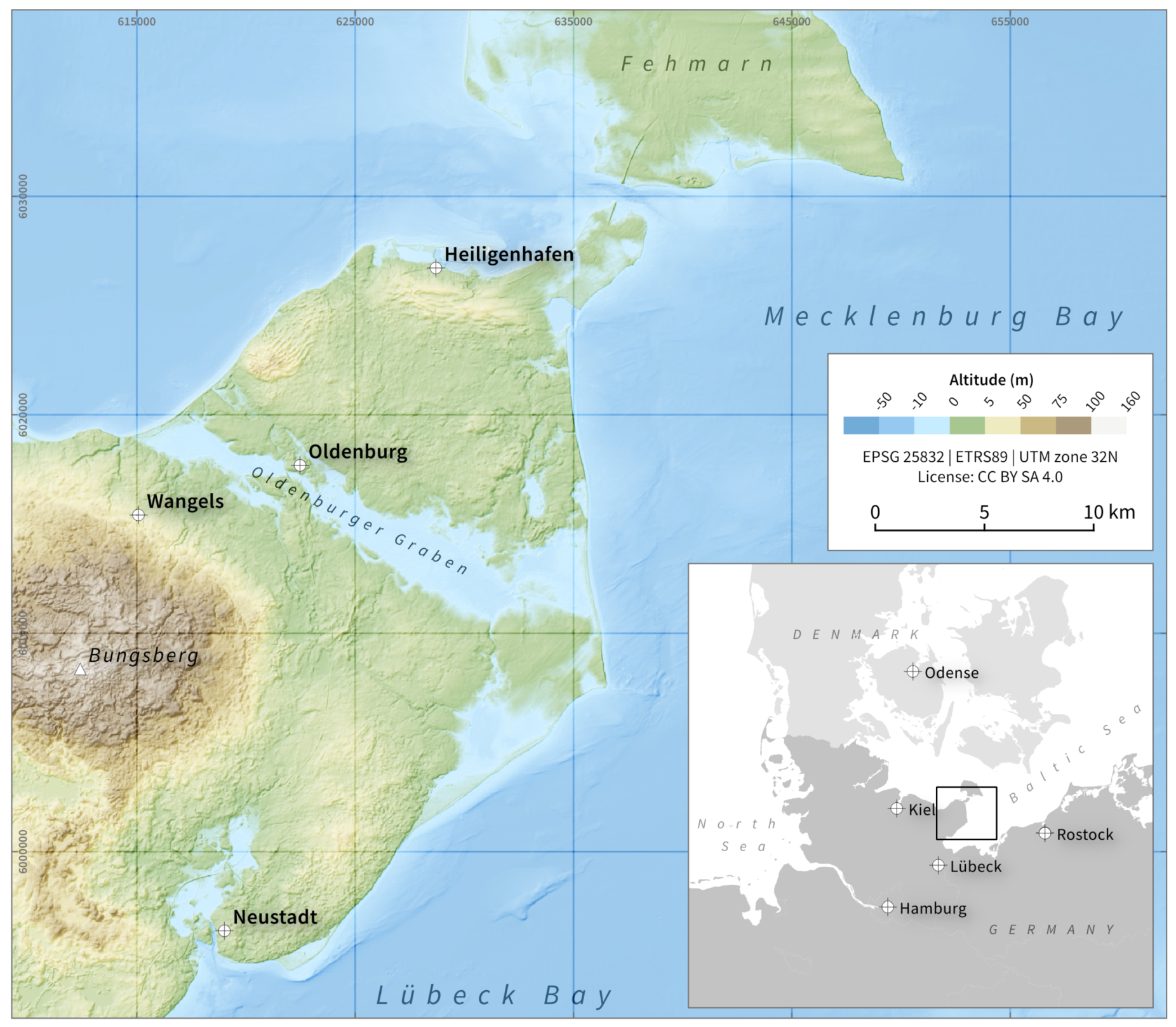
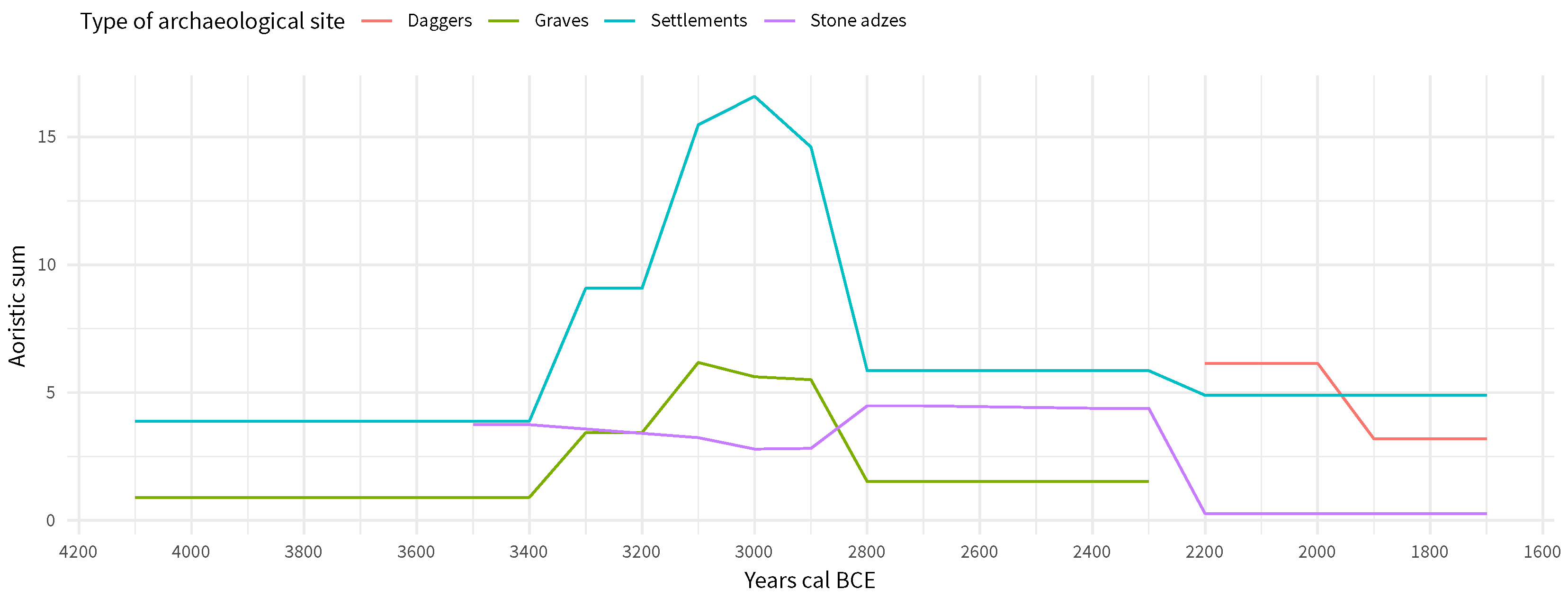
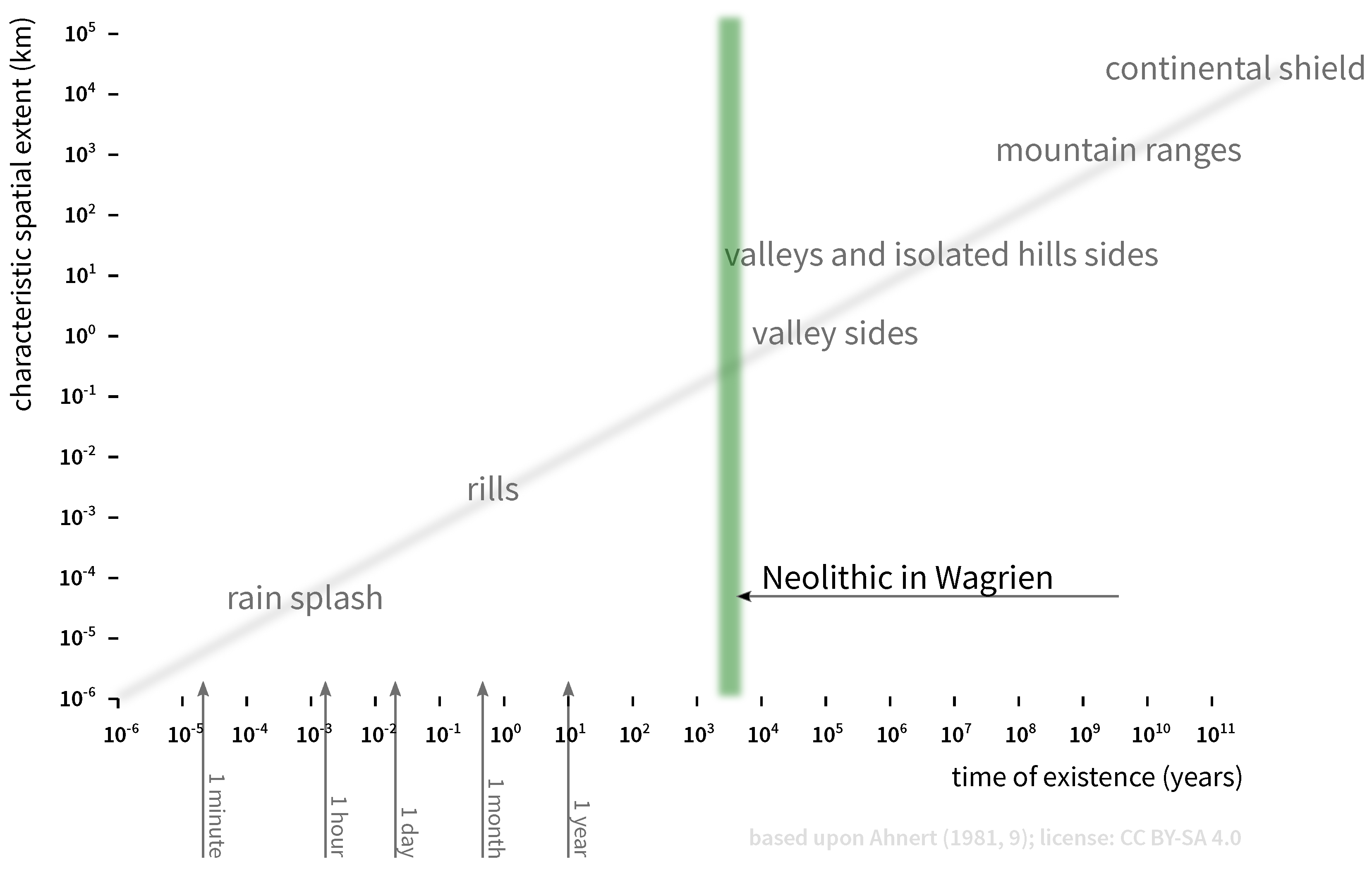
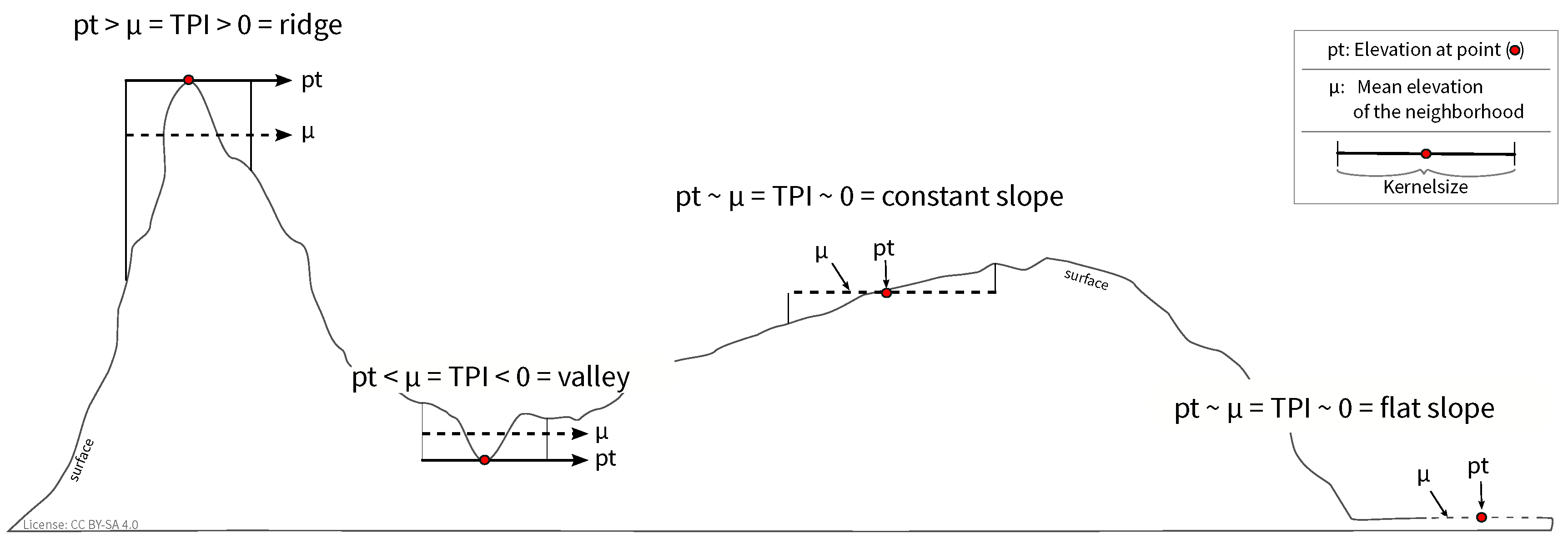
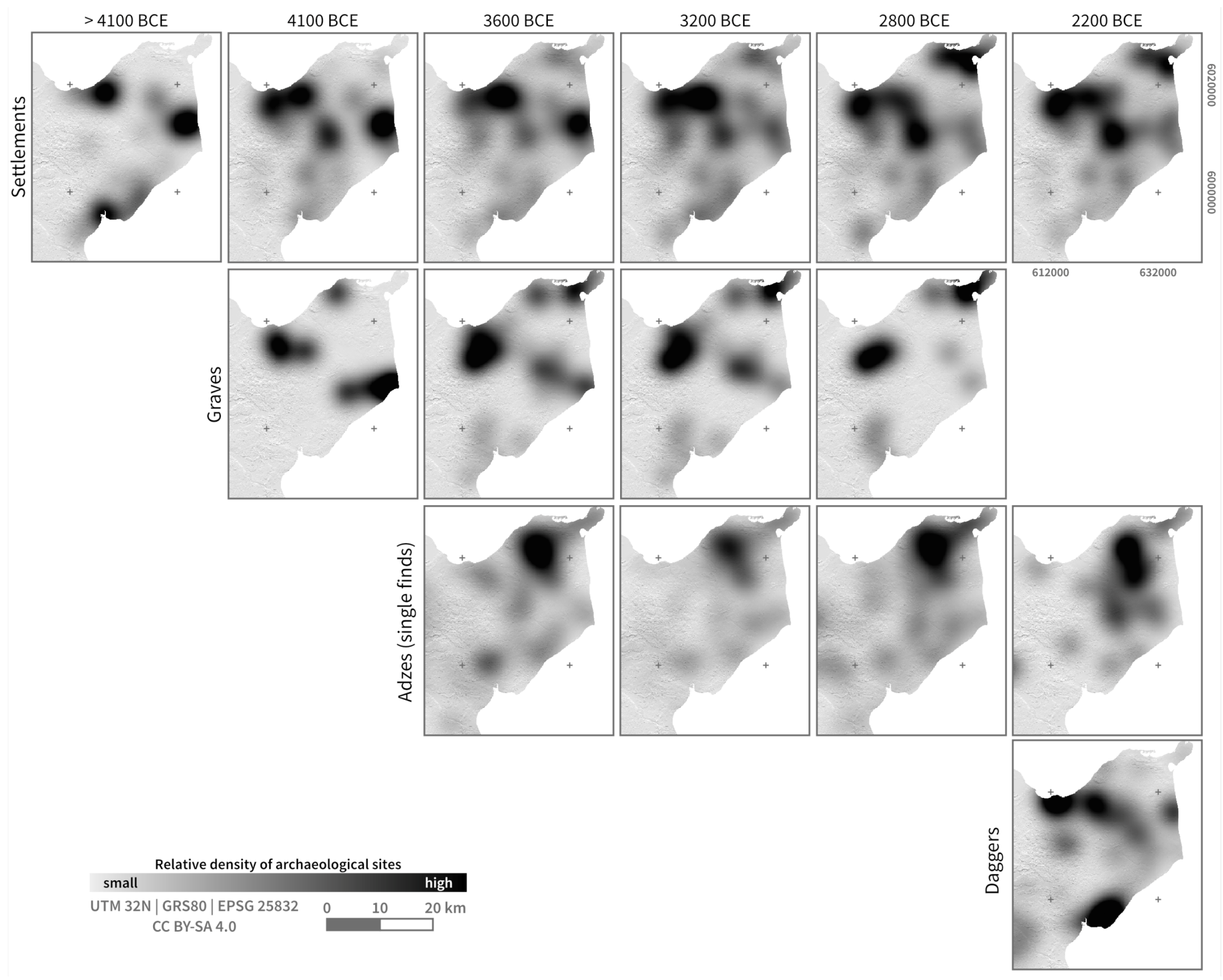
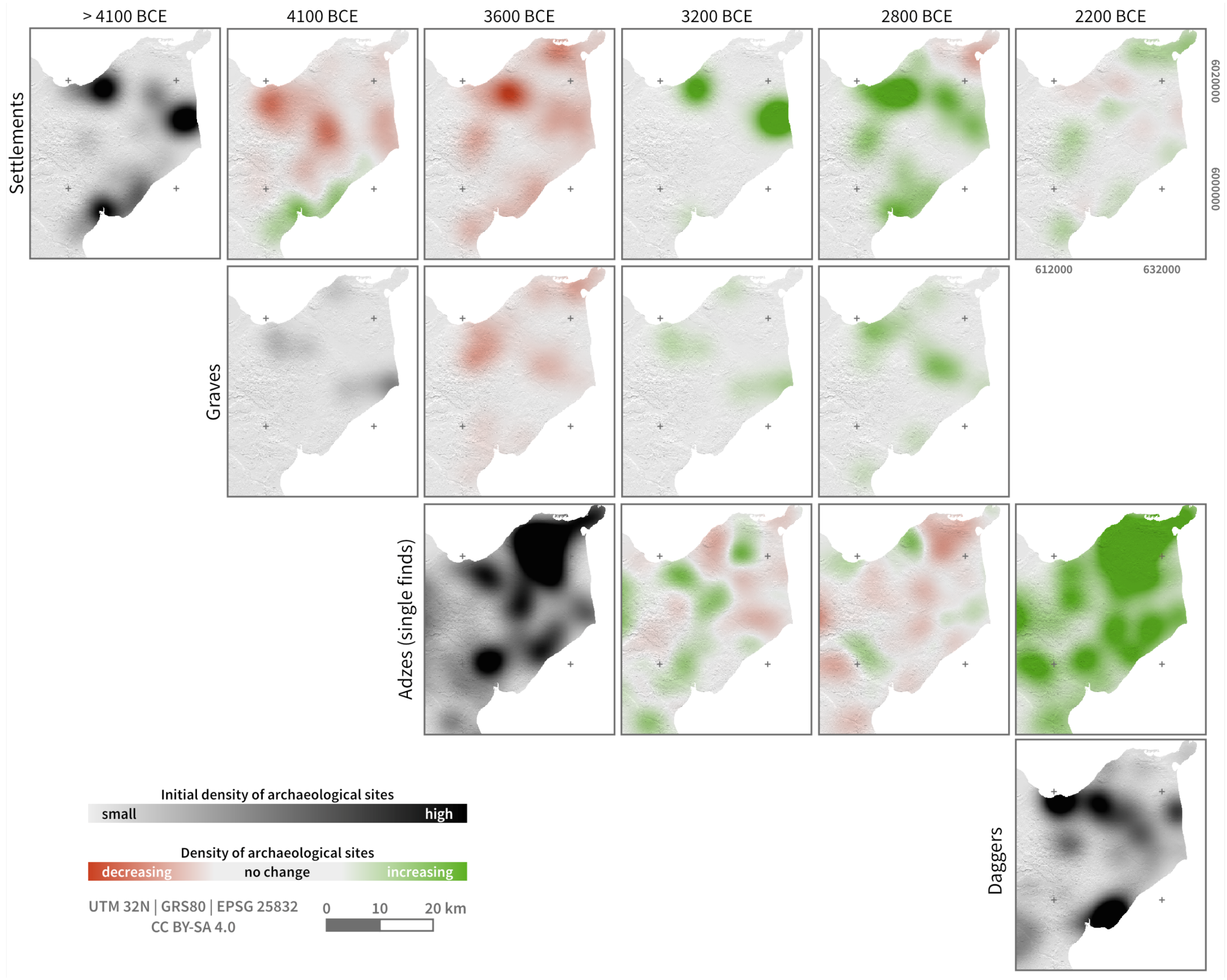
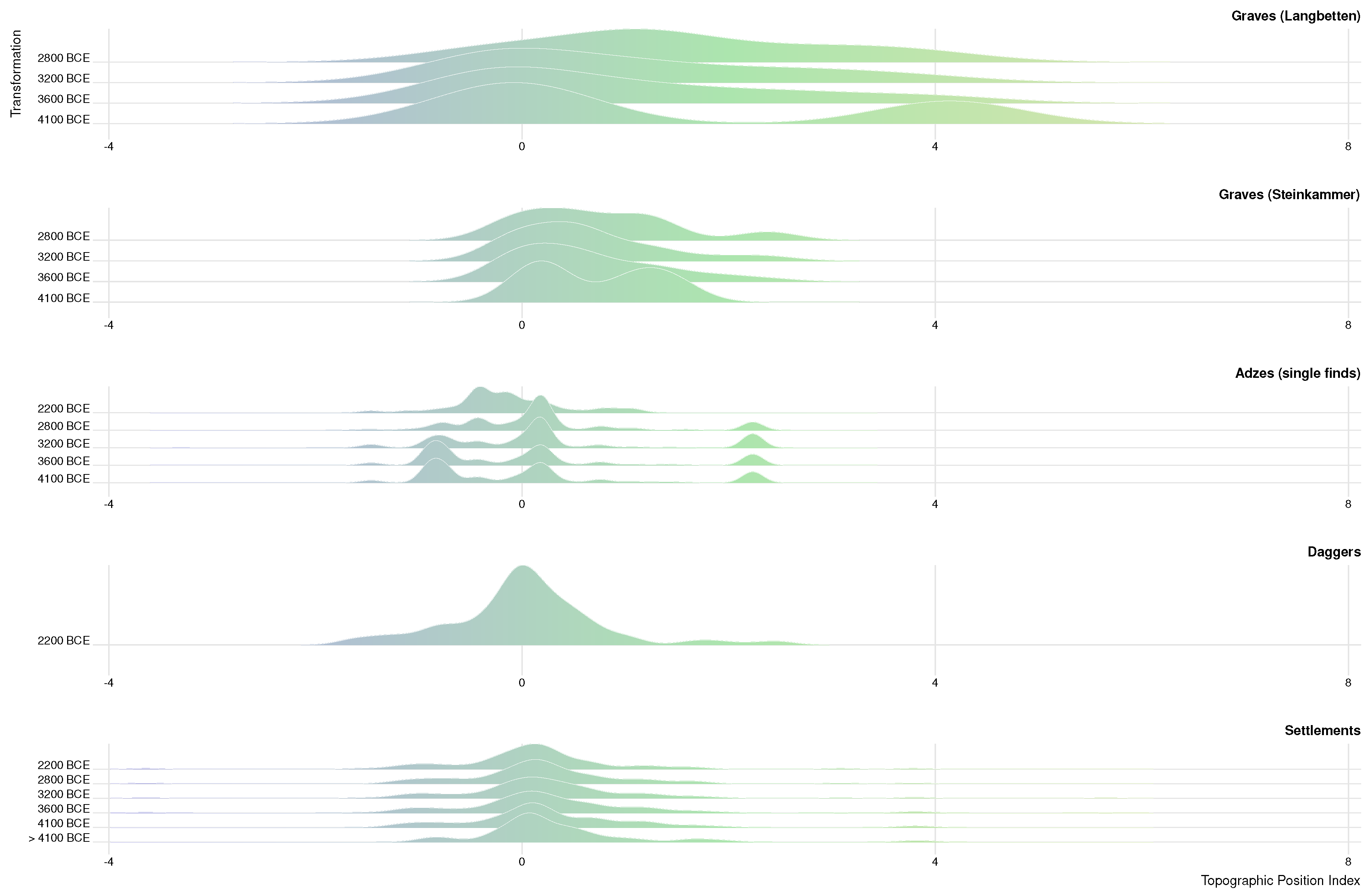
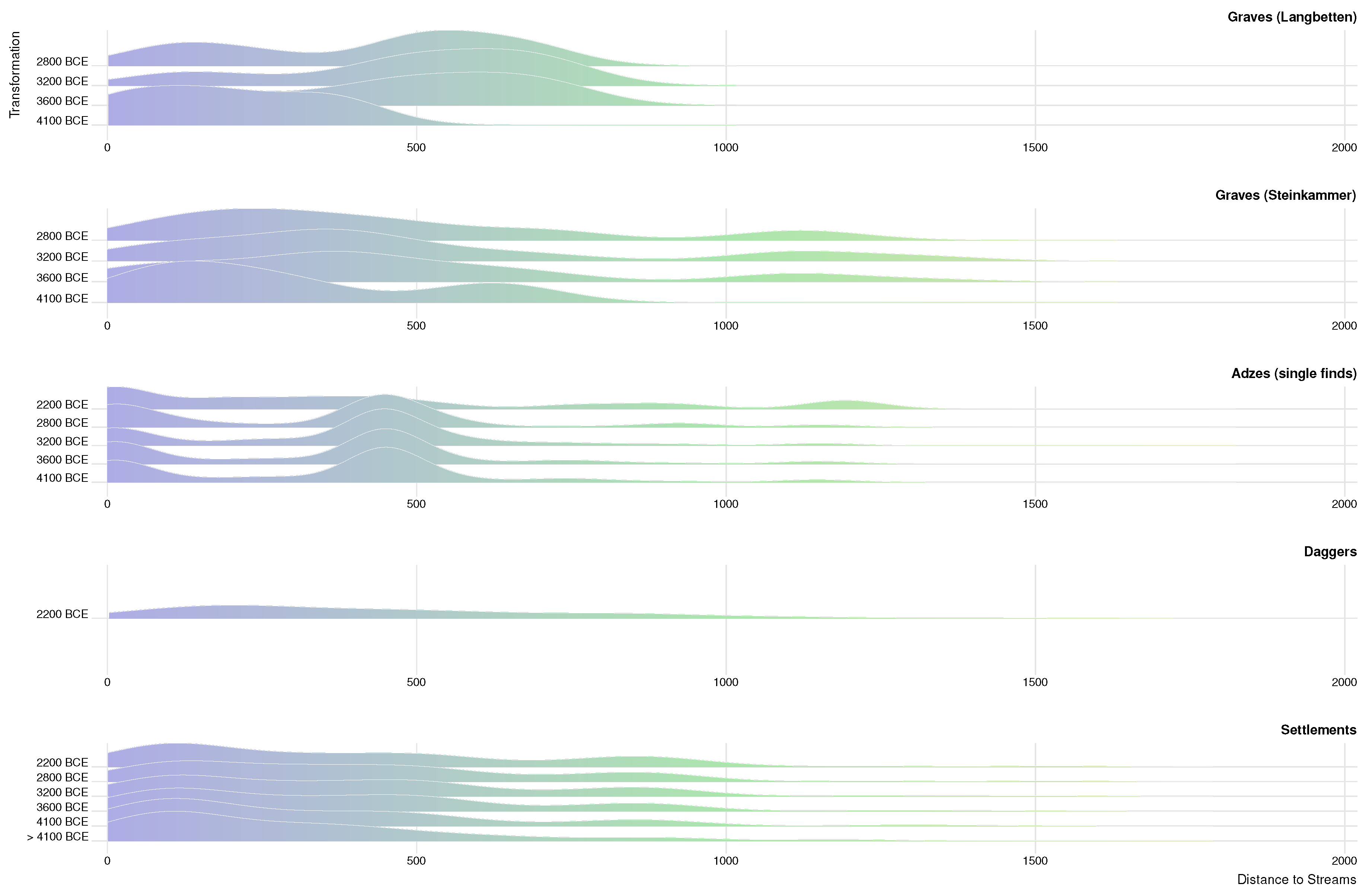
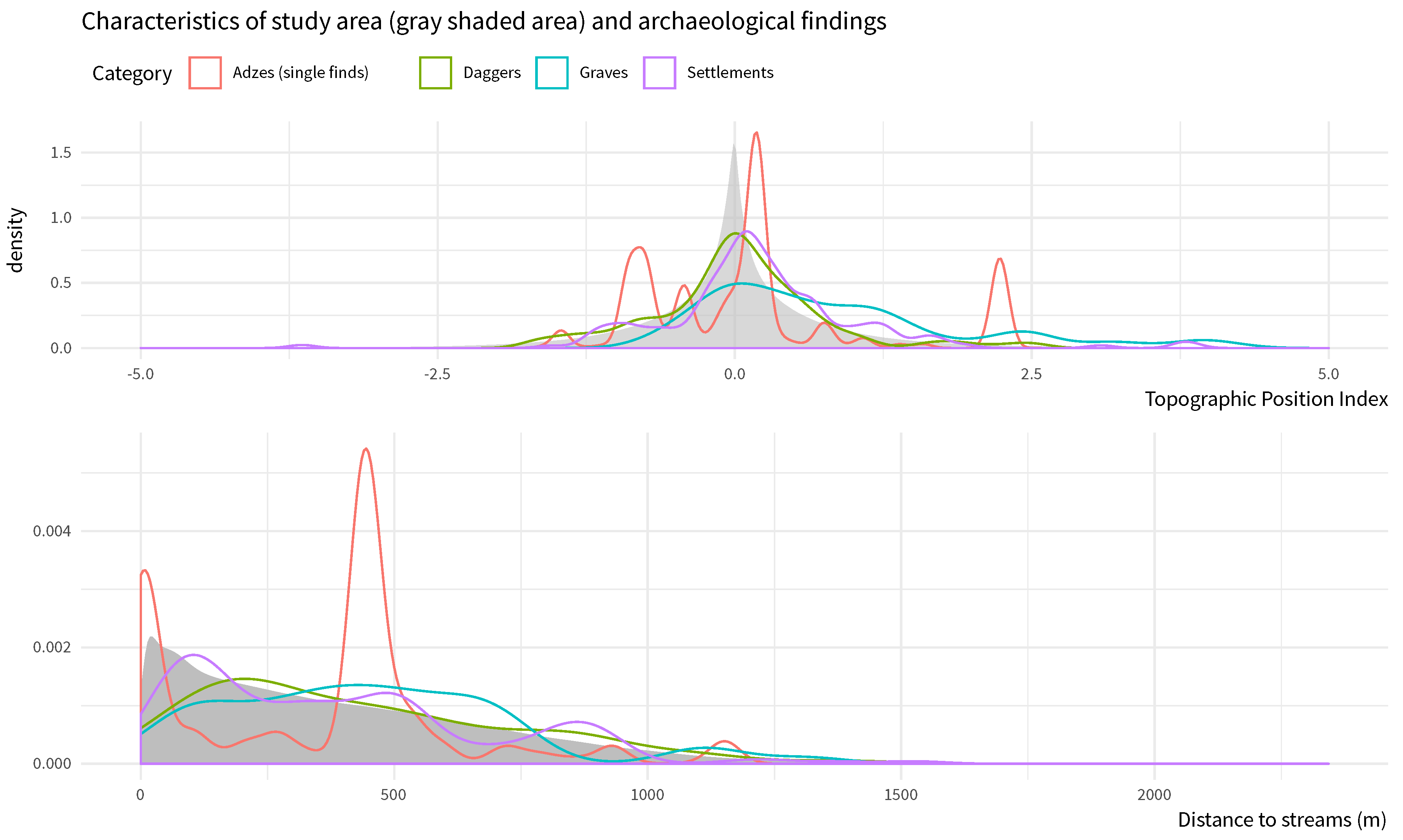
| Archaeological Culture | Name | Period | calBCE † |
|---|---|---|---|
| Ertebølle | Final Mesolithic | FM | 5300–4100 |
| Funnel Beaker Culture | Early Neolithic | EN Ia | 4100–3800 |
| EN Ib | 3800–3500 | ||
| EN II | 3500–3300 | ||
| Middle Neolithic | MN Ia | 3300–3200 | |
| MN Ib | 3200–3100 | ||
| MN II | 3100–3000 | ||
| MN III/IV | 3000–2900 | ||
| MN V | 2900–2800 | ||
| Single Grave Culture | Younger Neolithic | YN 1 | 2800–2600 |
| YN 2 | 2600–2400 | ||
| YN 3 | 2400–2200 | ||
| Dagger Groups | Late Neolithic | LN I | 2200–1900 |
| LN II | 1900–1700 |
© 2019 by the authors. Licensee MDPI, Basel, Switzerland. This article is an open access article distributed under the terms and conditions of the Creative Commons Attribution (CC BY) license (http://creativecommons.org/licenses/by/4.0/).
Share and Cite
Knitter, D.; Brozio, J.P.; Hamer, W.; Duttmann, R.; Müller, J.; Nakoinz, O. Transformations and Site Locations from a Landscape Archaeological Perspective: The Case of Neolithic Wagrien, Schleswig-Holstein, Germany. Land 2019, 8, 68. https://doi.org/10.3390/land8040068
Knitter D, Brozio JP, Hamer W, Duttmann R, Müller J, Nakoinz O. Transformations and Site Locations from a Landscape Archaeological Perspective: The Case of Neolithic Wagrien, Schleswig-Holstein, Germany. Land. 2019; 8(4):68. https://doi.org/10.3390/land8040068
Chicago/Turabian StyleKnitter, Daniel, Jan Piet Brozio, Wolfgang Hamer, Rainer Duttmann, Johannes Müller, and Oliver Nakoinz. 2019. "Transformations and Site Locations from a Landscape Archaeological Perspective: The Case of Neolithic Wagrien, Schleswig-Holstein, Germany" Land 8, no. 4: 68. https://doi.org/10.3390/land8040068





